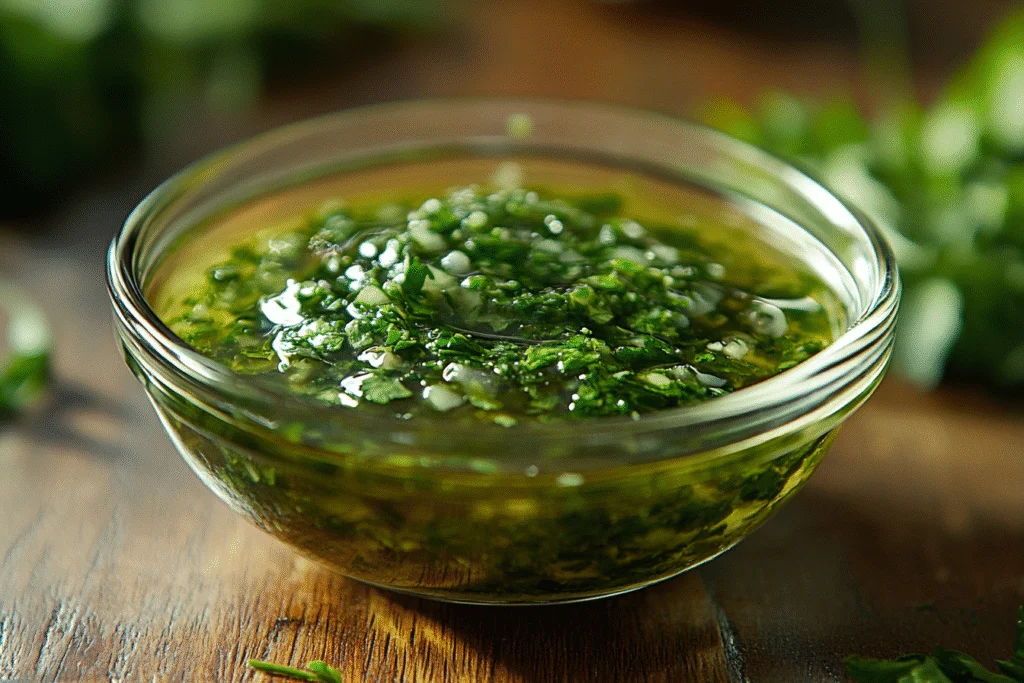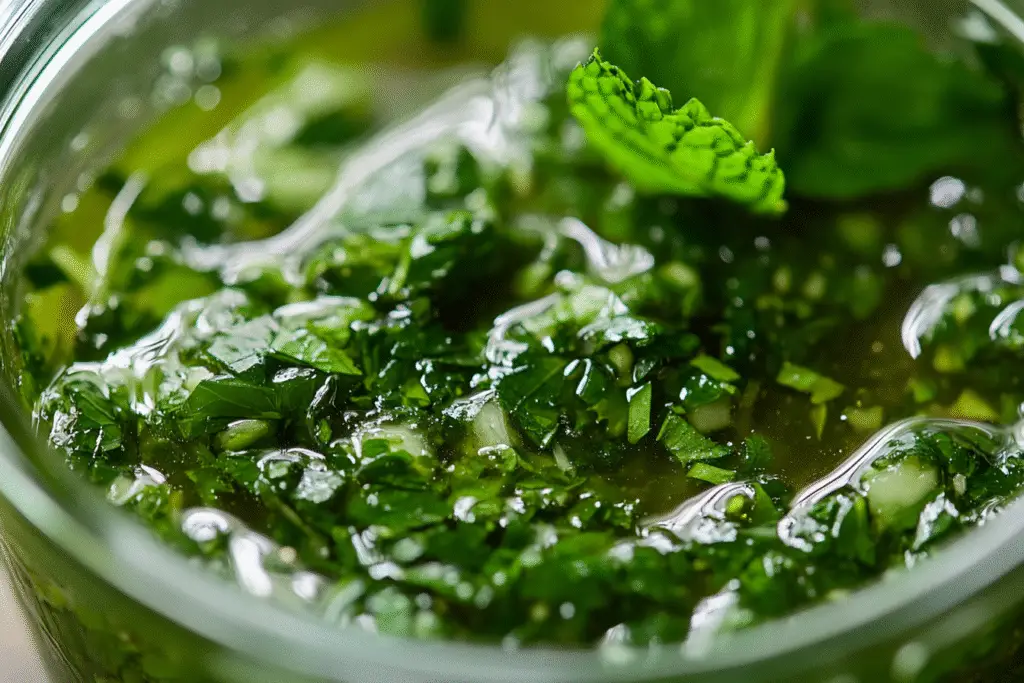The Enduring Charm of Mint Sauce
Homemade Mint Sauce is a classic British condiment, celebrated for its bright, tangy flavor and its unique ability to cut through rich, savory dishes—particularly roasted lamb. Unlike the thick, sweet mint jelly commonly found in jars, traditional mint sauce is loose, vinegary, and deeply aromatic. It’s a simple yet transformative accompaniment that brings a refreshing sharpness to a meal, enhancing every bite with herbal zing.
What makes homemade mint sauce so special is the freshness that pre-made versions often lack. When prepared from scratch, the vibrant flavor of fresh mint stands front and center, perfectly balanced by acidity and a subtle touch of sweetness. It’s a sauce that’s quick to make, requires minimal ingredients, and yet adds a restaurant-quality touch to your home-cooked roasts, grilled meats, or even vegetable dishes.
This versatile condiment isn’t just for lamb—it complements potatoes, peas, and even grilled halloumi or falafel. Learning to make your own mint sauce unlocks a bright, customizable addition to your cooking arsenal that will quickly become a go-to side for your Sunday roasts and beyond.
Selecting the Best Ingredients for Maximum Freshness
Fresh Mint:
- Fresh Spearmint: The best choice for mint sauce due to its sweet, mild, and classic flavor profile.
- Avoid Peppermint: It’s much stronger and can overpower the sauce.
- Leaves Only: Remove the stems for a smoother texture and cleaner flavor.
Vinegar:
- Malt Vinegar: The traditional choice for British mint sauce, offering a robust, tangy base.
- White Wine Vinegar: Lighter and brighter, excellent if you prefer a less assertive acidity.
- Apple Cider Vinegar: Adds a slight fruitiness and works well if malt vinegar is unavailable.
Sweetener:
- Granulated Sugar: Balances the sharpness of the vinegar.
- Honey or Maple Syrup: Can be used for a more subtle, natural sweetness.

Essential Equipment for Perfect Mint Sauce
- Sharp Knife or Herb Scissors: To finely chop the mint without bruising it.
- Small Mixing Bowl or Jar: For combining and storing the sauce.
- Spoon or Small Whisk: For dissolving sugar and blending the ingredients evenly.
- Measuring Spoons: To ensure a balanced vinegar-to-sugar ratio.
Common Mistakes and How to Avoid Them
1. Using Dry or Wilted Mint
Freshness is key. Use vibrant, green, aromatic leaves. Wilted mint will result in a dull sauce with muted flavor.
2. Skipping the Steeping Step
Letting the sauce sit for at least 10 minutes allows the flavors to meld and the mint to infuse the vinegar properly.
3. Overpowering with Vinegar
The sauce should be tangy but not harsh. Sweetness balances the acidity, and the proper ratio is essential to avoid a puckering taste.

Ingredient Swaps and Dietary Adjustments
- Vinegar-Free Option: Substitute with fresh lemon juice for a citrusy twist.
- Sugar Alternatives: Swap granulated sugar with honey, agave, or maple syrup to suit dietary needs.
- Herb Variations: Try adding a small amount of fresh parsley or coriander for an herbal blend.
Mint sauce is naturally gluten-free, vegan, and low in fat, making it a flexible addition to most diets.
Prep-Ahead and Time-Saving Tips
- Make Ahead: Mint sauce can be made up to 3 days in advance and stored in the refrigerator. The flavor deepens beautifully over time.
- Quick Steeping: Use warm water when dissolving sugar to speed up the process and intensify flavor infusion.
- Double Batch: It keeps well and is versatile enough to use across multiple meals.
Flavor Boosters and Pairing Ideas
- Add a Pinch of Salt: Enhances the mint’s freshness and rounds out the sharpness.
- Optional Garlic: A hint of finely minced garlic can add a savory undertone.
- Chili Flakes: For a touch of heat, especially if serving with grilled meats or falafel.
Perfect Pairings:
- Roast Lamb: The most traditional and perfect pairing.
- New Potatoes: Drizzle over or toss with boiled new potatoes.
- Peas: Stir into freshly steamed peas for a quick flavor upgrade.
- Grilled Vegetables: Particularly eggplant, zucchini, and peppers.
- Halloumi: A beautiful contrast to the salty, grilled cheese.
- Falafel or Shawarma: For a Middle Eastern-inspired twist.
Homemade Mint Sauce Recipe
Ingredients
- 1 cup (loosely packed) fresh mint leaves, finely chopped
- 4 tablespoons malt vinegar (or white wine vinegar)
- 2 tablespoons granulated sugar (adjust to taste)
- 2 tablespoons hot water
- Pinch of salt (optional)
Instructions
Step 1: Prepare the Mint
- Finely chop the fresh mint leaves using a sharp knife or herb scissors. Set aside.
Step 2: Dissolve the Sugar
- In a small bowl, mix the sugar with the hot water until fully dissolved.
Step 3: Combine Ingredients
- Stir in the vinegar and a pinch of salt if using.
- Add the chopped mint and stir to combine thoroughly.
Step 4: Let It Steep
- Allow the sauce to sit for at least 10–15 minutes at room temperature to let the flavors meld.
(For deeper flavor, refrigerate for 1–2 hours or overnight.)
Step 5: Taste and Adjust
- Taste the sauce and adjust the sweetness or acidity as needed by adding more sugar or vinegar to balance your preference.
Step 6: Serve
- Serve at room temperature with roast lamb, potatoes, peas, or your favorite dishes.
Storage and Shelf Life
- Refrigerator: Store in an airtight jar or container for up to 5 days.
- Freezing: Not recommended, as freezing will degrade the texture and flavor of the fresh mint.
- Make Fresh for Best Flavor: Though it keeps, the most vibrant flavor is in the first 1–2 days.
Troubleshooting Tips
- Too Sharp? Add a little extra sugar or dilute with a splash of water.
- Too Sweet? Balance with more vinegar or a squeeze of lemon.
- Dull Flavor? Use fresher mint or allow a longer steeping time for the flavors to develop.
Variations: British Mint Sauce vs. Mint Jelly
- Mint Sauce: Loose, vinegar-based, tangy, and lightly sweetened.
- Mint Jelly: Thick, gelatinous, and much sweeter with a mild mint flavor.
Mint sauce provides a brighter, fresher punch, whereas mint jelly is more subdued and sweet. Homemade mint sauce is ideal for those who prefer a more natural, herbaceous condiment.
Serving Suggestions
- Roast Lamb: The most iconic pairing.
- New Potatoes: Tossed with a drizzle of mint sauce for a fresh side dish.
- Green Vegetables: Drizzle over steamed peas, green beans, or asparagus.
- Grilled Meats: Lamb chops, chicken skewers, or pork.
- Middle Eastern Dishes: Excellent with falafel, shawarma, or grilled halloumi.
- Summer Salads: Stir a spoonful into potato or grain-based salads for brightness.
For drinks, pair mint sauce-accented meals with a crisp white wine, sparkling water with lemon, or a classic mint lemonade to echo the fresh, herbal flavors.
